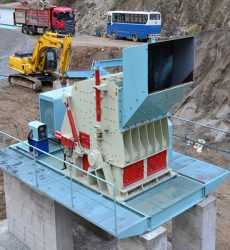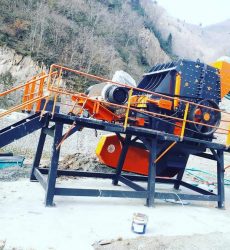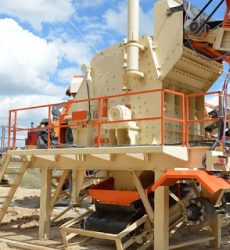
The secondary impact crusher is used to shrink hard materials such as limestone, dolomite, granite and basalt. It provides a reduction ratio up to the size of the concrete aggregate. Large-size materials from the primary crusher can be fed directly. Impact crushers are the most preferred crushers, as their investment and operating costs are lower than other crushers. According to the design of the facility, they can produce mobile, fixed steel feet, fixed skid chassis, pre-screened or pre-fed production.
Working Principle of Secondary Impact Crusher
Secondary impact crushers consist of 3 different parts. These are the rotor, the fixed lower body and the collapsible upper body. The upper body rotor rotates and opens around a fixed joint to the lower body thanks to the hydraulic mechanism. The lower body carrier is fixed to the chassis and its purpose is to carry the rotor. The upper body is mounted on the lower body. In secondary impact crusher machines, there are two grinding jaw mechanisms, upper and lower, in order to adjust the product curve. The products are brought to the desired size by changing the distance between the grinding parts and the rotor.
The motion pallets given to the rotor create a high level of kinetic energy. Thanks to the kinetic energy, strong blows can be applied to the desired material. Thanks to the impact, the material entering the process hits the crushing plates and is broken into pieces. The materials that come to a size that can pass between the rotor pallets and grinders in the first crushing stage are reduced to such an extent that they pass between the rotor pallets and the jaw mechanism in the second and third crushing stages and go to the discharge chute.
The upper jaw in the secondary impact crusher moves on the slides on the sides of the upper body and the distance between the rotor blades and the grinder can be adjusted. It can be done easily thanks to the settings with the hydraulic mechanism. There are grinding profiles on the lower jaw. Rotor pallets can create the closest distance thanks to the grinding profiles.
General Features of Secondary Impact Crusher
Secondary impact crushers are called secondary crushers and reduce the coarse materials obtained by jaw crushers to asphalt and aggregate fineness. They work in the way that the striking pallets on the rotor hit the stone and throw it against the crusher bars forming the crusher ceiling. Thanks to this event, which is repeated over and over, materials with small structures are obtained. This machine, which is used in crushing and screening plants, provides cubical production with materials fed between 200-400 mm. Its most distinctive features are its easy maintenance and low cost ratio.
Pallets: Can be used upside down or straight. It is resistant to breakage and is self-centred and assembled. The pallet, which is tightly attached to the rotor body with special wedges, is fixed to the pallet holders against lateral movements. Thus, it protects its location.
Linings in secondary impact crushers: Resistant to abrasion. Linings made of high manganese alloy steel casting are produced in parts for easy replacement and are connected to the body with the help of bolts.
The rotors of the crushers are made of cast steel. The heat-treated rotor is supported by hardfacing welds to prevent damage when subjected to wear. Opposite the machine pulley, there is an empty running flywheel without a groove to help balance the load. The flywheel and the machine pulley can be replaced.
Body: The body of the crushers with welded design is durable and long-lasting. It consists of two structures, the lower body and the upper body. While the lower body is fixed, the upper body can be opened and closed. Hydraulic cylinders are used during the on-off operation. At the same time, there are observation covers on both sides of the body. In this way, the adjustment process can be controlled and the condition of the wearing parts can be checked.
Generally speaking, secondary impact crushers provide high performance. It has pallets and pendulum resistant to abrasion. Thanks to the hydraulic cylinders, an easy and reliable pendulum adjustment can be made and it offers easy and fast maintenance. Thanks to hydraulic cylinders, pallets and liners are easily accessible. It is easy to assemble and operate.
Secondary Impact Crusher Technicial Specification
There are 4 models of secondary impact crushers produced by Diçelik Makine. These are models Di-Çelik-Dmk-01, Di-Çelik-Dmk-02, Di-Çelik-Dmk-03 and Di-Çelik-Dmk-04. While the rotor diameter of the first 3 models is 1120 mm, the rotor diameter of the Di-Çelik-Dmk-04 model is 1280 mm. The rotor widths are 1000, 1250, 1500 and 1750 mm, respectively. The feeding dimensions are 300 mm in the first three models and 400 mm in the last model.
The capacity of K01 model can be up to 100-150 tons, 02 model 150-200 tons, 03 model 200-300 tons and 04 model 250-400 tons. When looking at the engine power, it is respectively 160 kilowatts, 200 kilowatts, 250-315 kilowatts and 315-400 kilowatts. Their weights are 17000, 22000, 26000 and 29000 kilograms, respectively.
| Model | Di-Çelik-DMK-K01 | Di-Çelik-DMK-02 | Di-Çelik-DMK-03 | Di-Çelik-DMK-04 |
| Rotor Diameter | 1120 (mm) | 1120 (mm) | 1120 (mm) | 1280 (mm) |
| Rotor Width | 1000 (mm) | 1250 (mm) | 1500 (mm) | 1750 (mm) |
| Feed Size | 300 (mm) | 300 (mm) | 300 (mm) | 400 (mm) |
| Capacity | 100-150 (ton) | 150-200 (ton) | 200-300 (ton) | 250-400 (ton) |
| Motor Power | 160 (kW) | 200 (kW) | 250-315 (kW) | 315-400 (kW) |
| Weight | 17000 (kg) | 22000 (kg) | 26000 (kg) | 29000 (kg) |





